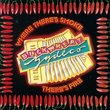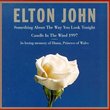| All Artists: Otis Taylor Title: Recapturing the Banjo Members Wishing: 7 Total Copies: 0 Label: Telarc Original Release Date: 1/1/2008 Re-Release Date: 2/5/2008 Genres: Country, Blues, Pop Styles: Contemporary Blues, Electric Blues, Acoustic Blues, Modern Blues Number of Discs: 1 SwapaCD Credits: 1 UPC: 089408366727 |
Search - Otis Taylor :: Recapturing the Banjo
 | Otis Taylor Recapturing the Banjo Genres: Country, Blues, Pop
The concept of America as a great melting pot is a double-edged sword. In the great sweep of cultural evolution over the past two and a half centuries, certain lines of connection and distinction have been obscured. Americ... more » |
CD DetailsSynopsis
Album Description The concept of America as a great melting pot is a double-edged sword. In the great sweep of cultural evolution over the past two and a half centuries, certain lines of connection and distinction have been obscured. American popular music, a hybrid and distillation of sources too numerous and diverse to mention, is perhaps one of the best examples of the difficulty in determining exactly what came from where. The banjo, for example, is an instrument whose historical roots dig much deeper than the American folk and bluegrass traditions with which it is commonly associated. The banjo ultimately originated in Africa, and made its way to America with the African slaves who were brought to the fledgling colonies as early as the 1700s. Bluesman and multi-instrumentalist Otis Taylor, who shatters the illusions of the status quo time and again via his uniquely haunting songcraft and musicianship, sheds new light on this centuries-old instrument with his new Telarc recording, Recapturing the Banjo. The album includes riveting performances by Taylor along with some of the most accomplished banjo players on the current roots mus"The banjo has become so closely associated with folk singers and bluegrass players," says Taylor. "Over the years, the instrument just lost touch with its roots, and I'm just trying to re-establish that connection." ic scene: Guy Davis, Corey Harris, Alvin Youngblood Hart, Keb' Mo' and Don Vappie - a group that collectively boasts an impressive array of GRAMMY Awards, Handy Awards, Blues Music Awards, a MacArthur Fellowship and numerous other accolades. The musicians on this recording utilize a variety of banjo styles, notes music historian Dick Weissman, author of the album's liner notes. Guy Davis' version of "Little Liza Jane," which showcases the clawhammer picking style, is probably the closest thing contemporary audiences will hear to a traditional banjo performance. Alvin Youngblood Hart performs "Deep Blue Sea" in a modified traditional style, using the sort of syncopation that's reminiscent of Dink Roberts. Keb' Mo' plays with finger picks in a style reminiscent of the period where mountain banjo turned into bluegrass, while Don Vappie plays tenor banjo in a more modern version of what St. Cyr and Scott were playing in New Orleans during the 1920s. "Walk Right In," originally penned by banjoist and jug band musician Gus Cannon, recaptures the vintage jug band feel that Cannon helped define. Other tunes on the recording utilize contemporary blues banjo interpretations that pay homage to the work of such seminal mid-20th century blues musicians as John Lee Hooker and Muddy Waters. Even Jimi Hendrix fans will find a familiar touchstone in the banjo rendition of well known "Hey Joe." Similar CDs
Similarly Requested CDs
|
CD ReviewsBlack Banjo alive and living in the present and the future! Tony Thomas | SUNNY ISLES BEACH, FL USA | 03/25/2008 (5 out of 5 stars) "The rest of this review really speaks to the musicians other than the Great Don Vappie. Vappie's music reflects the tradition of four and six-string banjo and guitar playing that remained among Creoles in New Orleans as well as on the musics shared between African American Creoles in New Orleans with Afro-Caribbean Creoles on islands like Haiti, Martinique, and Guadaloupe. Vappie who was once one of the leading Jazz and R & B recording session guitarists and Bassists returned to the four and six string banjos played by the great banjoist of Jazz. In doing so Vappie is playing very authentic roots music in fact rooted in the very neighborhood in New Orleans he grew up in, yet he has become a world-class music. Recapturing the Banjo is not chiefly about repeating or even elaborating on the traditional banjo styles created by Black traditional five-string banjoists or the great Jazz banjoists of the 20s and 1930s. Rather, it is about using the banjo for new styles and new music of African Americans today. Very few of the recordings here follow the traditional finger or frailing styles used by the last generations of Black banjoists who can be found on field recordings like Black Banjo Songsters or Black Appalachia. This terrain has been explored by traditionally oriented Black string bands like the Carolina Chocolate Drops or the Ebony Hillbillies or individual players like Sparkey Rucker, Sule Greg Wilson, Rex Ellis, or my humble self. Rather, the artists here use the banjo for the mostly blues related music that they have all been creating for years. All of these musicians are not new to the banjo. Otis has told me that the banjo was his first instrument and he plays his other instruments, the guitar and the mandolin, the way he plays the banjo, not the standard ways. There is a famous picture printed in the Denver Post in the early 1960s on his web site. A younger slimmer Otis Taylor is seen riding a unicycle and playing the banjo on his way to high school! You can find some great traditional banjo playing on older CDs by Corey Harris and Alvin Youngblood Hart. What we have hear is blues and trance music and ballads influenced by this. What we have here is the creative use of amplification both in recording the banjo and in use of electric banjo and banjos with electric pickups. We have new rhythms for new times. The importance of this is that in African American popular and folk culture, the arrival of Blues and the forms of pop and folk Ragtime and Jazz that were associated with the Blues was what led to the demise of the five-string banjo among Black folk. For reasons I will elaborate in a book forthcoming from Duke UP called _Lost in the Mix__ (I am just writing one chapter) the actual five string banjos available at the time the Blues rolled in at the turn of the century were not as suitable for Blues playing as the inexpesnive steel-stringed guitar that had become available to southern folk just as the blues spread at the turn of the 19th to the 20th Century. The contemporary experience of Blues as a kind of caberet or concert music obscures the fact that Blues was a dance music. Blues singers like Robert Johnson, Charlie Patton, or Lightnin' Hopkins, may have played in the street at times, but they made their money playing for dancers in juke joints and at house parties. Rather than the two or three minute Blues performances we get from recordings and reproductions of recordings, these actual Blues performances were often fifteen, twenty, or even thirty minute dance numbers. The five-string banjo was not condusive to playing the rhythm that Black folks danced these blues to. So, it retreated to smaller enclaves where the older music persisted, especially in the Piedmont and Appalachians of the Upper South. Even there, Black five string banjoists played the Blues, but blues that moved to the rhythm of the old dance movements. Very much of the revival of traditional Black banjo playing has been playing these old dance tunes and rhythms. Yet, we live in a world whose musical culture has been transformed by the Blues and the musics it has spawned. In its Africanness, the five-string banjo provides a great platform for playing blues. The dance demands of a 1900 juke joint and the limitation of gut stringed banjos are gone. Steel stringed tone ringed banjos and modern amplication create different possibilities for the banjo. Blues rhythm has become more complex. These musicians expert in the Blues and in the Black banjo tradition, reverse history and bring back the Blues to the Banjo and the Banjo to the Blues. The result is powerful music that returns the banjo to the arsnel of comtemporary African American music. It lives, not as a recreation of a lost past, but as a living expression of the present " Authentic-sounding roots music Rick Cornell | Reno, Nv USA | 02/22/2008 (5 out of 5 stars) "As I listened to this, I thought of one of Steve Martin's old routines, back when he was a silly, unknown, stand-up comedian ca. 1976. He used to pull out a banjo and get "happy feet." No matter how glum the subject at hand, the banjo would give him ... "happy feet." Yes, when you think of "Duelling Banjos" from "Deliverance," or the Flatt & Scruggs or Doc Watson flat-picking style, such as the theme from "The Beverly Hillbillies," or a zillion versions of "Orange Blossom Special," you get Martin's point. But this c.d. isn't about that. This is Otis Taylor (tripling as producer and arranger), with other banjoists Alvin Youngblood Hart, Guy Davis, Corey Harris and Don Vappie, creating (for the most part) the "Negro experience" of the 19th Century. I say "for the most part"; the ubiquitous Keb' Mo' appears, with his set-ender "The Way It Goes." Just a guess here, but I doubt that the "Negro experience of the 19th Century" had anything to do with road rage! As such, this c.d. is dark. No flashiness here. And songs - a mix of originals, "traditional folk songs," and folks songs such as "Walk Right In" (originally made famous in the early 1960's by The Rooftop Singers, but in fact, written by an African American banjo player, Gus Cannon, in the early 20th century about a kind housewife who invites a peddler in to her house) - which are quite dark. We have songs about a man running from the Ku Klux Klan, about a "scary drunk" on absinthe, about a Black cowboy who shoots in self-defense and knows he will get no justice, about a drowning man, and about a White sheriff who refuses to investigate the disappearance of a Black woman. No "happy feet" in this recording! But it all sounds authentic. This recording reminds me of the best of John Fahey. Nothing flashy - just real. A stark recapture of times past, and uncomfortable times at that. But times past that always need to be remembered. And if we didn't know that the banjo was part of those times before, we certainly know it now. This c.d. got a 5-star review in "Down Beat," which gives maybe 3 5-star reviews a year. I think the historic and sociological significance of the album is the reason for that. RC" What A Surprise! MPQ | San Diego, Ca. United States | 02/15/2008 (5 out of 5 stars) "At first I resisted even listening to this CD, figuring anything with banjo in the title was going to be some sort of hillbilly, boring music. But after seeing the great line up of musicians, I figured it was worth at least checking out. What a surprise! A lot of good songs here, most done with a band with the banjo out front. An unbelievable version of "Hey Joe" as well. Well worth checking into. It's something different in a generic world."
|

 Track Listings (14) - Disc #1
Track Listings (14) - Disc #1







